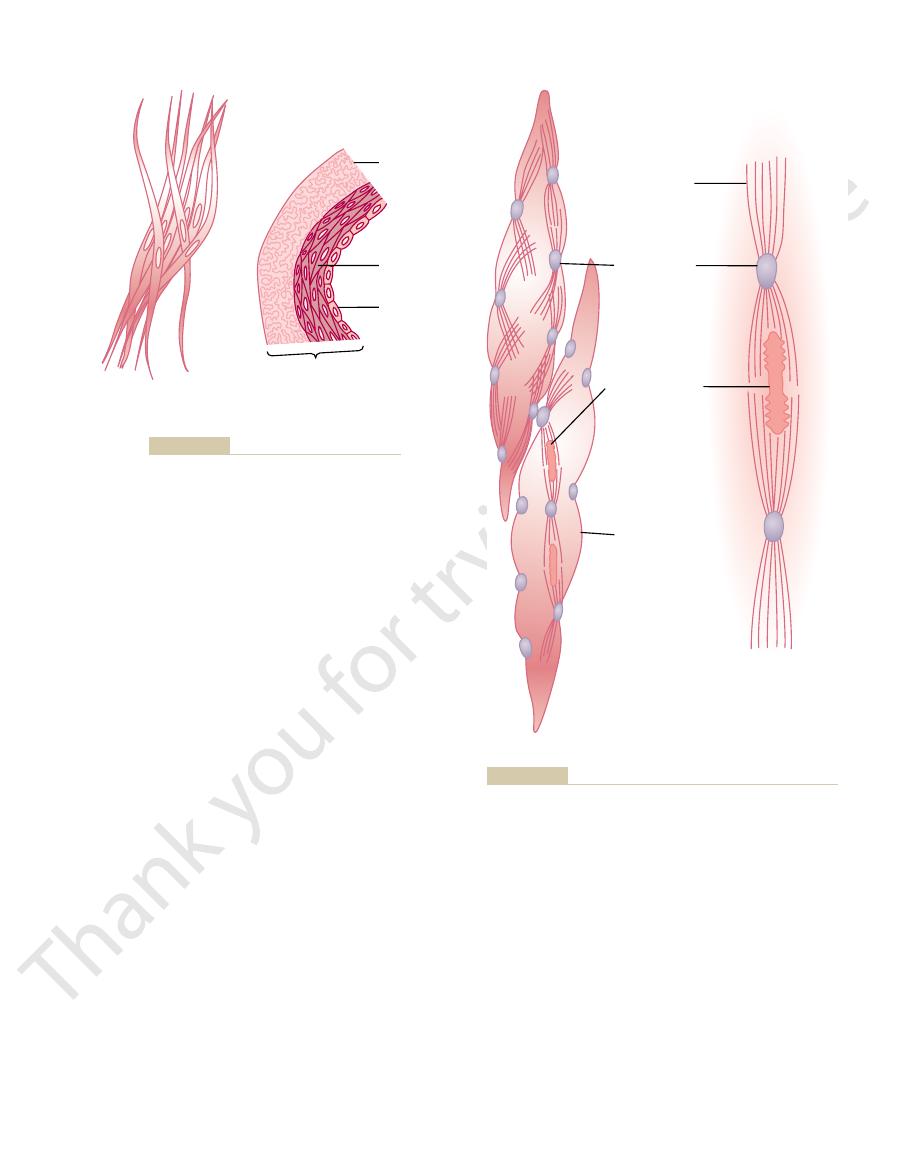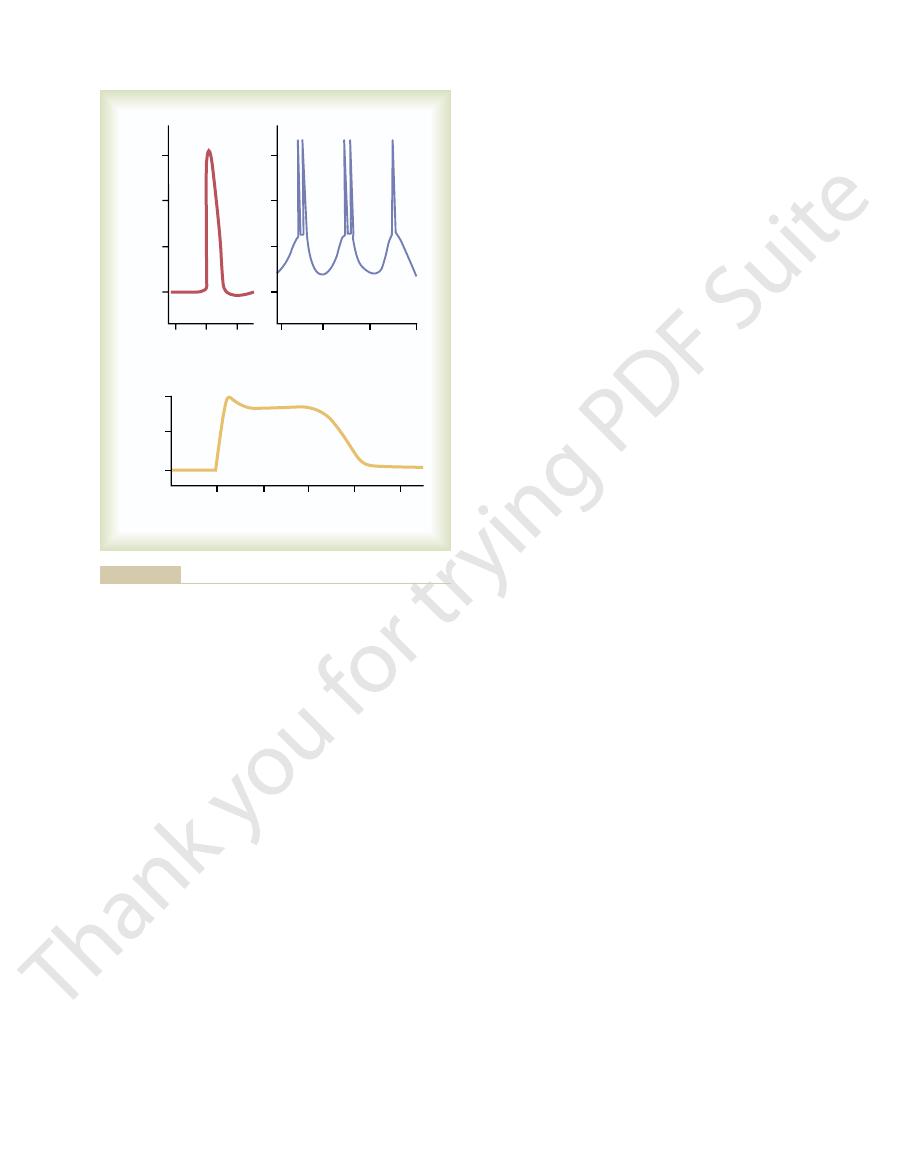
transmitted to the next. In addition, the cell membranes are joined by many
are arranged in sheets or bundles, and their cell membranes are adherent to one
smooth muscle fibers that contract together as a single unit. The fibers usually
single muscle fibers. Instead, it means a mass of hundreds to thousands of
The term “unitary” is confusing because it does not mean
Unitary Smooth Muscle.
muscle are the ciliary muscle of the eye, the iris muscle of the eye, and the pilo-
muscle is exerted by non-nervous stimuli. Some examples of multi-unit smooth
mainly by nerve signals. In contrast, a major share of control of unitary smooth
each fiber can contract independently of the others, and their control is exerted
The most important characteristic of multi-unit smooth muscle fibers is that
from one another.
fibers, are covered by a thin layer of basement membrane–like substance, a
fibers. Further, the outer surfaces of these fibers, like those of skeletal muscle
and often is innervated by a single nerve ending, as occurs for skeletal muscle
separate smooth muscle fibers. Each fiber operates independently of the others
This type of smooth muscle is composed of discrete,
smooth muscle.
divided into two major types, which are shown in Figure 8–1:
(5) function. Yet, for the sake of simplicity, smooth muscle can generally be
(3) response to different types of stimuli, (4) characteristics of innervation, and
in several ways: (1) physical dimensions, (2) organization into bundles or sheets,
The smooth muscle of each organ is distinctive from that of most other organs
Types of Smooth Muscle
skeletal muscle, but the internal physical arrangement of smooth muscle fibers
to skeletal muscle. Most important, essentially the same attractive forces
as long. Many of the same principles of contraction apply to smooth muscle as
to 500 micrometers in length. In contrast, skeletal
muscle, which is composed of far smaller fibers—
with skeletal muscle. We now turn to smooth
In Chapters 6 and 7, the discussion was concerned
C
H
A
P
T
E
R
8
92
Contraction and Excitation
of Smooth Muscle
Contraction of Smooth
Muscle
usually 1 to 5 micrometers in diameter and only 20
muscle fibers are as much as 30 times greater in diameter and hundreds of times
between myosin and actin filaments cause contraction in smooth muscle as in
is very different.
multi-unit smooth
muscle and unitary (or single-unit)
Multi-Unit Smooth Muscle.
mixture of fine collagen and glycoprotein that helps insulate the separate fibers
erector muscles that cause erection of the hairs when stimulated by the sym-
pathetic nervous system.
another at multiple points so that force generated in one muscle fiber can be
gap
junctions through which ions can flow freely from one muscle cell to the next
so that action potentials or simple ion flow without action potentials can travel

together by intercellular protein bridges. It is mainly
Others are dispersed inside the cell. Some of the mem-
these bodies are attached to the cell membrane.
dense bodies.
Figure 8–2. This figure shows large numbers of actin
in skeletal muscle. Instead, electron micrographic tech-
by calcium ions, duration of contraction, and amount
contraction coupling, control of the contractile process
skeletal muscle, as well as differences in excitation-
There are, however, major differences between the
by calcium ions, and adenosine triphosphate (ATP) is
tal muscle. Further, the contractile process is activated
chapter.
is different. This is discussed in detail later in this
traction, so the mechanism for control of contraction
of the actin and myosin filaments in skeletal muscle.
ments,
Contractile Mechanism in
ducts, ureters, uterus, and many blood vessels.
of most viscera of the body, including the gut, bile
cytial interconnections among fibers. It is also called
to contract together. This type of smooth muscle is also
Chapter 8
Contraction and Excitation of Smooth Muscle
93
from one fiber to the next and cause the muscle fibers
known as syncytial smooth muscle because of its syn-
visceral smooth muscle because it is found in the walls
Smooth Muscle
Chemical Basis for Smooth
Muscle Contraction
Smooth muscle contains both actin and myosin fila-
having chemical characteristics similar to those
It does not contain the normal troponin complex
that is required in the control of skeletal muscle con-
Chemical studies have shown that actin and myosin
filaments derived from smooth muscle interact with
each other in much the same way that they do in skele-
degraded to adenosine diphosphate (ADP) to provide
the energy for contraction.
physical organization of smooth muscle and that of
of energy required for contraction.
Physical Basis for Smooth Muscle Contraction
Smooth muscle does not have the same striated
arrangement of actin and myosin filaments as is found
niques suggest the physical organization exhibited in
filaments attached to so-called
Some of
brane dense bodies of adjacent cells are bonded
through these bonds that the force of contraction is
transmitted from one cell to the next.
Multi-unit smooth muscle
A
Unitary smooth muscle
Small artery
Endothelium
Medial
muscle fibers
B
Adventitia
and unitary
Figure 8–1
Multi-unit (A)
(B) smooth muscle.
Actin
filaments
Dense bodies
Cell membrane
Myosin filaments
hand fiber and the right-hand diagram demonstrate the relation of
shows actin filaments radiating from dense bodies. The lower left-
Physical structure of smooth muscle. The upper left-hand fiber
Figure 8–2
myosin filaments to actin filaments.

bladder. However, during the next 15 seconds to a
increase in fluid volume in the urinary bladder, thus
been elongated or shortened. For example, a sudden
organs, is its ability to return to nearly its original
tant characteristic of smooth muscle, especially the vis-
or hormonal sources.
muscle for hours with little use of energy. Little con-
The importance of the latch mechanism is that it
skeletal muscle contraction. This is called the “latch”
1/300 the energy required for comparable sustained
contraction is often minuscule, sometimes as little as
traction. Further, the energy consumed to maintain
level, yet the muscle maintains its full force of con-
contraction, the amount of continuing excitation
bridges to the actin filaments.
with 3 to 4 kilograms for skeletal muscle. This great
cross-sectional area for smooth muscle, in comparison
than that of skeletal muscle—as great as 4 to 6 kg/cm
slow cycling time of the cross-bridges, the maximum
myosin filaments in smooth muscle, and despite the
much slower than in skeletal muscle, as discussed later.
cross-bridges with the actin filaments. In addition, the
as well as its prolonged contraction, is caused by
The slow onset of contraction of smooth muscle,
or as long as 30 seconds.
because there are so many types of smooth muscle,
contraction of an average skeletal muscle fiber. But
seconds. This is about 30 times as long as a single
2 seconds, giving a total contraction time of 1 to 3
excited, reaches full contraction about 0.5 second later,
Smooth Muscle Tissue.
Slowness of Onset of Contraction and Relaxation of the Total
indefinitely.
tines, urinary bladder, gallbladder, and other viscera
economy of the body, because organs such as the intes-
This sparsity of energy utilization by smooth muscle
required for each cycle, regardless of its duration.
bridges and because only one molecule of ATP is
slow attachment and detachment cycling of the cross-
skeletal muscle. This, too, is believed to result from the
1/10 to 1/300 as much energy is required to sustain the
corresponding slowing of the rate of cycling.
of the cross-bridge heads is greatly reduced, with
dation of the ATP that energizes the movements
ATPase activity than in skeletal muscle, so that degra-
cycling is that the cross-bridge heads have far less
in smooth muscle. A possible reason for the slow
force of contraction, is believed to be greatly increased
ments, which is a major factor that determines the
1/300 that in skeletal muscle. Yet the
tal muscle; in fact, the frequency is as little as 1/10 to
is much, much slower in smooth muscle than in skele-
from the actin, and reattachment for the next cycle—
muscle—that is, their attachment to actin, then release
of cycling of the myosin cross-bridges in smooth
The rapidity
Following are some of the differences.
versus skeletal muscle contraction would differ.
days.Therefore, it is to be expected that both the physi-
tonic contraction, sometimes lasting hours or even
rapidly, most smooth muscle contraction is prolonged
skeletal muscle.
of being limited to less than 30 per cent, as occurs in
site direction on the other side. The value of this
opposite direction. This allows the myosin to pull an
ments have what are called “sidepolar” cross-bridges
There is another difference: Most of the myosin fila-
same role as the Z discs in skeletal muscle.
in fact, the dense bodies of smooth muscle serve the
similar to the contractile unit of skeletal muscle, but
between the dense bodies. This contractile unit is
radiating from two dense bodies; the ends of these
muscle cell, showing large numbers of actin filaments
To the right in Figure 8–2 is a postulated structure
as many actin filaments as myosin filaments.
electron micrographs, one usually finds 5 to 10 times
eter more than twice that of the actin filaments. In
muscle fiber are myosin filaments. These have a diam-
Membrane Physiology, Nerve, and Muscle
94
Unit II
Interspersed among the actin filaments in the
of an individual contractile unit within a smooth
filaments overlap a myosin filament located midway
without the regularity of the skeletal muscle structure;
arranged so that the bridges on one side hinge in one
direction and those on the other side hinge in the
actin filament in one direction on one side while simul-
taneously pulling another actin filament in the oppo-
organization is that it allows smooth muscle cells to
contract as much as 80 per cent of their length instead
Comparison of Smooth Muscle Contraction
and Skeletal Muscle Contraction
Although most skeletal muscles contract and relax
cal and the chemical characteristics of smooth muscle
Slow Cycling of the Myosin Cross-Bridges.
fraction of time
that the cross-bridges remain attached to the actin fila-
Energy Required to Sustain Smooth Muscle Contraction.
Only
same tension of contraction in smooth muscle as in
is exceedingly important to the overall energy
often maintain tonic muscle contraction almost
A typical smooth muscle tissue
begins to contract 50 to 100 milliseconds after it is
and then declines in contractile force in another 1 to
contraction of some types can be as short as 0.2 second
the slowness of attachment and detachment of the
initiation of contraction in response to calcium ions is
Force of Muscle Contraction.
Despite the relatively few
force of contraction of smooth muscle is often greater
2
force of smooth muscle contraction results from the
prolonged period of attachment of the myosin cross-
“Latch” Mechanism for Prolonged Holding of Contractions of
Smooth Muscle.
Once smooth muscle has developed full
usually can be reduced to far less than the initial
mechanism.
can maintain prolonged tonic contraction in smooth
tinued excitatory signal is required from nerve fibers
Stress-Relaxation of Smooth Muscle.
Another impor-
ceral unitary type of smooth muscle of many hollow
force of contraction seconds or minutes after it has
stretching the smooth muscle in the bladder wall,
causes an immediate large increase in pressure in the

in smooth muscle. Instead, the
of Smooth Muscle
of smooth muscle contraction, followed by hormonal
Therefore, in this section, we discuss nervous control
which is another difference from skeletal muscle.
that can initiate the contractile process. Still other
the muscle, and in several other ways. The principal
nervous signals, by hormonal stimulation, by stretch of
stimulated to contract by multiple types of signals: by
sively by the nervous system, smooth muscle can be
Nervous and Hormonal Control
detaches.
to ADP except on the rare occasion when a head
is used by the muscle, because ATP is not degraded
tension is maintained, or “latched”; yet little energy
remains large. Because the number of heads attached
the cycling period. Therefore, the number of heads
but at the same time, the deactivation of these enzymes
enzymes decreases, the cycling frequency decreases,
contraction are great. Then, as the activation of the
quency of the myosin heads and the velocity of
enzymes are both strongly activated, the cycling fre-
When the myosin kinase and myosin phosphatase
of the simplest is the following.
the many mechanisms that have been postulated, one
many attempts have been made to explain it. Among
muscle organs without much expenditure of energy,
in smooth muscle, and because this phenomenon
muscle contraction, therefore, is determined to a great
contraction ceases. The time required for relaxation of
the regulatory light chain. Then the cycling stops and
smooth muscle cell, which splits the phosphate from
myosin phosphatase,
head. Reversal of this requires another enzyme,
reverse, except for the phosphorylation of the myosin
ical level, the aforementioned processes automatically
When the calcium ion concentration falls below a crit-
the same as occurs for skeletal muscle, thus
the entire cycling process of intermittent “pulls,”
when the regulatory chain is phosphorylated, the
head with the actin filament does not occur. But
attachment-detachment cycling of the myosin
When this chain is not phosphorylated, the
phosphorylated in response to this myosin kinase.
regulatory chain,
head, called the
3. One of the light chains of each myosin
enzyme.
, a phosphorylating
2. The calmodulin-calcium combination joins with
1. The calcium ions bind with calmodulin.
cross-bridges. This activation and subsequent contrac-
tion. Calmodulin does this by activating the myosin
Although this protein is similar to troponin, it is
place of troponin, smooth muscle cells contain a large
Myosin Kinase and Phosphorylation of the Myosin Head.
mechanism, as follows.
to cause skeletal muscle contraction. Instead, smooth
Yet smooth muscle does not contain troponin, the
environment of the fiber.
stretch of the fiber, or even change in the chemical
tion of the smooth muscle fiber, hormonal stimulation,
intracellular calcium ions. This increase can be caused
As is true for skeletal muscle, the initiating stimulus
by Calcium Ions
Regulation of Contraction
large changes in volume.
tance is that, except for short periods of time, they
Their impor-
original level. These phenomena are called
Conversely, when the volume is suddenly decreased,
another step, the same effect occurs again.
original level. Then, when the volume is increased by
wall, the pressure returns almost exactly back to the
minute or so, despite continued stretch of the bladder
Chapter 8
Contraction and Excitation of Smooth Muscle
95
the pressure falls very low at first but then rises back
in another few seconds or minutes to or near to the
stress-
relaxation and reverse stress-relaxation.
allow a hollow organ to maintain about the same
amount of pressure inside its lumen despite long-term,
for most smooth muscle contraction is an increase in
in different types of smooth muscle by nerve stimula-
regulatory protein that is activated by calcium ions
muscle contraction is activated by an entirely different
Combination of Calcium Ions with Calmodulin—Activation of
In
amount of another regulatory protein called calmod-
ulin.
different in the manner in which it initiates contrac-
tion occur in the following sequence:
and activates myosin kinase
becomes
head has the capability of binding repetitively
with the actin filament and proceeding through
causing muscle contraction.
Cessation of Contraction—Role of Myosin Phosphatase.
located in the fluids of the
extent by the amount of active myosin phosphatase in
the cell.
Possible Mechanism for Regulation of the
Latch Phenomenon
Because of the importance of the latch phenomenon
allows long-term maintenance of tone in many smooth
allows the myosin heads to remain attached to the
actin filament for a longer and longer proportion of
attached to the actin filament at any given time
to the actin determines the static force of contraction,
of Smooth Muscle Contraction
Although skeletal muscle fibers are stimulated exclu-
reason for the difference is that the smooth muscle
membrane contains many types of receptor proteins
receptor proteins inhibit smooth muscle contraction,
control and other means of control.
Neuromuscular Junctions
Physiologic Anatomy of Smooth Muscle Neuromuscular Junc-
tions.
Neuromuscular junctions of the highly struc-
tured type found on skeletal muscle fibers do not occur
autonomic nerve fibers
that innervate smooth muscle generally branch

as 1000 milliseconds (1 second). The importance of
repolarization of the muscle fiber membrane, the repo-
typical spike potential. However, instead of rapid
smooth muscle action potential with a plateau. The
Figure 8–4
Action Potentials with Plateaus.
muscle fiber itself, as discussed subsequently.
stretch, or as a result of spontaneous generation in the
action of transmitter substances from nerve fibers, by
the action of hormones on the smooth muscle, by the
many ways, for example, by electrical stimulation, by
Figure 8–4
action potential is 10 to 50 milliseconds, as shown in
unitary smooth muscle. The duration of this type of
as those seen in skeletal muscle, occur in most types of
Typical spike action potentials, such
(2) action potentials with plateaus.
occur in one of two forms: (1) spike potentials or
The action potentials of visceral smooth muscle
most, multi-unit types of smooth muscle, as discussed
muscle. They do not normally occur in many, if not
Action Potentials in Unitary Smooth Muscle.
millivolts less negative than in skeletal muscle.
60 millivolts, which is about 30
the normal resting state, the intracellular potential is
depends on the momentary condition of the muscle. In
The quantitative
Potentials in Smooth Muscle
Membrane Potentials and Action
effective in causing the excitation or inhibition. These
two transmitters, acetylcholine or norepinephrine, is
Thus, the type
inhibitory receptors.
excitatory receptors,
on the surface of the muscle cell membrane.
But why these different responses? The answer is
fiber, norepinephrine usually excites it.
inhibits it. Conversely, when acetylcholine inhibits a
excites a muscle fiber, norepinephrine ordinarily
smooth muscle in other organs. When acetylcholine
secreted by the same nerve fibers. Acetylcholine is an
norepinephrine,
acetylcholine
The most
Excitatory and Inhibitory Transmitter Substances Secreted at
the diffuse junctions.
way as the skeletal muscle neuromuscular junction; the
contact junctions,
occurs in the skeletal muscle junction. These are called
of smooth muscle, the varicosities are separated from
In a few instances, particularly in the multi-unit type
acetylcholine
contain acetylcholine, the vesicles of the autonomic
the vesicles of skeletal muscle junctions, which always
that contain transmitter substance. But, in contrast to
the walls of the varicosities. In the varicosities are vesi-
Schwann cells
distributed along their axes. At these points the
motor end plate on skeletal muscle fibers. Instead,
The axons that innervate smooth muscle fibers do
of the transmitter substance.
outer layer, and muscle excitation travels from this
muscle cells, the nerve fibers often innervate only the
the cells. Furthermore, where there are many layers of
muscle cells; the transmitter substance then diffuses to
in Figure 8–3. In most instances, these fibers do not
diffusely on top of a sheet of muscle fibers, as shown
Membrane Physiology, Nerve, and Muscle
96
Unit II
make direct contact with the smooth muscle fiber cell
membranes but instead form so-called diffuse junc-
tions that secrete their transmitter substance into the
matrix coating of the smooth muscle often a few
nanometers to a few micrometers away from the
outer layer to the inner layers by action potential con-
duction in the muscle mass or by additional diffusion
not have typical branching end feet of the type in the
most of the fine terminal axons have multiple vari-
cosities
that envelop the axons are interrupted
so that transmitter substance can be secreted through
cles similar to those in the skeletal muscle end plate
nerve fiber endings contain
in some
fibers and norepinephrine in others—and occasionally
other substances as well.
the muscle cell membrane by as little as 20 to 30
nanometers—the same width as the synaptic cleft that
and they function in much the same
rapidity of contraction of these smooth muscle fibers
is considerably faster than that of fibers stimulated by
the Smooth Muscle Neuromuscular Junction.
important transmitter substances secreted by the
autonomic nerves innervating smooth muscle are
and
but they are never
excitatory transmitter substance for smooth muscle
fibers in some organs but an inhibitory transmitter for
that both acetylcholine and norepinephrine excite or
inhibit smooth muscle by first binding with a receptor
protein
Some of the receptor proteins are
whereas others are
of receptor determines whether the smooth muscle is
inhibited or excited and also determines which of the
receptors are discussed in more detail in Chapter 60 in
relation to function of the autonomic nervous system.
Membrane Potentials in Smooth Muscle.
voltage of the membrane potential of smooth muscle
usually about
-50 to -
Action poten-
tials occur in unitary smooth muscle (such as visceral
muscle) in the same way that they occur in skeletal
in a subsequent section.
Spike Potentials.
A. Such action potentials can be elicited in
C shows a
onset of this action potential is similar to that of the
larization is delayed for several hundred to as much
the plateau is that it can account for the prolonged
Visceral
Multi-unit
Varicosities
Figure 8–3
Innervation of smooth muscle.

The smooth muscle fibers of multi-unit smooth muscle
the direction of the anus.
contents away from the overfilled intestine, usually in
is overfilled by intestinal contents, local automatic con-
matically and rhythmically. For instance, when the gut
gut wall, when excessively stretched, to contract auto-
by the stretch itself. This response to stretch allows the
are generated. They result from a combination of (1)
sufficiently, spontaneous action potentials usually
When visceral (unitary) smooth muscle is stretched
pacemaker waves.
traction of the smooth muscle mass. Therefore, the
or more action potentials occur. These repetitive
effect, showing that at each peak of the slow wave, one
traction does occur. Figure 8–4
develops and spreads over the muscle mass. Then con-
most visceral smooth muscle), an action potential
traction, but when the peak of the negative slow wave
The slow waves themselves cannot cause muscle con-
are strong enough, they can initiate action potentials.
The importance of the slow waves is that, when they
the ion channels increase and decrease rhythmically.
active. Another suggestion is that the conductances of
membrane; that is, the membrane potential becomes
The cause of the slow wave rhythm is unknown. One
up the muscle mass.
the membranes of the muscle fibers. Instead, it is a
is not the action potential. That is, it is not a self-
The slow wave itself
the gut is shown in Figure 8–4
slow wave rhythm
an extrinsic stimulus. This often is associated with a
muscle is self-excitatory. That is, action potentials arise
Slow Wave Potentials in Unitary Smooth Muscle, and Sponta-
performs two tasks at once.
mechanism to cause contraction. Thus, the calcium
muscle fibers.
longer. This accounts in large measure for the pro-
sodium channels, and they also remain open much
and in skeletal muscle fibers. However, the calcium
potential. This occurs in the same self-regenerative
smooth muscle. Instead, flow of calcium ions to the
gated sodium channels. Therefore, sodium participates
The smooth muscle
Smooth Muscle Action Potential.
Importance of Calcium Channels in Generating the
contraction, as discussed in Chapters 9 and 10.)
(Also, this is the type of action potential seen in
ditions, and certain types of vascular smooth muscle.
muscle, such as the ureter, the uterus under some con-
Chapter 8
Contraction and Excitation of Smooth Muscle
97
contraction that occurs in some types of smooth
cardiac muscle fibers that have a prolonged period of
cell membrane has far more voltage-gated calcium
channels than does skeletal muscle but few voltage-
little in the generation of the action potential in most
interior of the fiber is mainly responsible for the action
way as occurs for the sodium channels in nerve fibers
channels open many times more slowly than do
longed plateau action potentials of some smooth
Another important feature of calcium ion entry into
the cells during the action potential is that the calcium
ions act directly on the smooth muscle contractile
neous Generation of Action Potentials.
Some smooth
within the smooth muscle cells themselves without
basic
of the membrane potential.
A typical slow wave in a visceral smooth muscle of
B.
regenerative process that spreads progressively over
local property of the smooth muscle fibers that make
suggestion is that the slow waves are caused by waxing
and waning of the pumping of positive ions (presum-
ably sodium ions) outward through the muscle fiber
more negative when sodium is pumped rapidly and
less negative when the sodium pump becomes less
potential inside the cell membrane rises in the positive
direction from
-60 to about -35 millivolts (the
approximate threshold for eliciting action potentials in
B demonstrates this
sequences of action potentials elicit rhythmical con-
slow waves are called
In Chapter 62,
we see that this type of pacemaker activity controls the
rhythmical contractions of the gut.
Excitation of Visceral Smooth Muscle by Muscle Stretch.
the normal slow wave potentials and (2) decrease in
overall negativity of the membrane potential caused
tractions often set up peristaltic waves that move the
Depolarization of Multi-Unit Smooth Muscle
Without Action Potentials
(such as the muscle of the iris of the eye or the
0
0.1
0.2
0.3
0.4
0
10
20
30
+ 20
50
100
Milliseconds
Millivolts
Millivolts
0
A
C
B
0
– 40
– 60
0
– 25
– 50
Seconds
Slow waves
Seconds
plateau, recorded from a smooth muscle fiber of the uterus.
by an external stimulus.
Typical smooth muscle action potential (spike potential) elicited
Figure 8–4
A,
B, Repetitive spike potentials, elicited by
slow rhythmical electrical waves that occur spontaneously in the
smooth muscle of the intestinal wall. C, Action potential with a

in blood vessels.
muscles in different locations. For example, norepi-
substances. In some instances, the same substance
different hormones, neurotransmitters, and other
calcium ion concentration in the sarcoplasm, thereby
ions out of the cell itself; these effects reduce the
The pump that moves calcium ions from the sar-
The cAMP or cGMP has many effects, one
messengers.
are coupled to these enzymes, causing the formation
in the cell membrane; the portions of
inhibit contraction, other receptor mechanisms are
ticulum; the calcium then induces contraction. To
internal change in the muscle fiber, such as release of
change in the membrane potential. In these instances,
the degree of negativity inside the muscle cell, a
to diffuse out of the cell. Both of these actions increase
channels are opened,
to prevent entry of these positive ions; inhi-
channels
Inhibition, in contrast, occurs when the hormone (or
larization allows calcium ion entry into the cell, which
zation occurs without action potentials, and this depo-
occurring may be enhanced. In other cases, depolari-
potentials result, or action potentials that are already
the same as after nerve stimulation. Sometimes action
calcium ion channels and depolarize the membrane,
mones or Local Tissue Factors.
rather than excitatory receptors.
Conversely, the hormone causes inhibition if the mem-
for the respective hormone.
histamine.
angiotensin, endothelin, vasopressin, oxytocin, sero-
norepinephrine, epinephrine, acetylcholine,
profound effects. Among the more important of
muscle contraction to some degree, and some have
diminished calcium ion concentration, and increased
Adenosine, lactic acid, increased potassium ions,
3. Increased hydrogen ion concentration causes
2. Excess carbon dioxide causes vasodilatation.
muscle relaxation and, therefore, vasodilatation.
1. Lack of oxygen in the local tissues causes smooth
the blood flow to the local tissue area. Some of the
way, a powerful local feedback control system controls
the vessel wall, thus allowing for increased flow. In this
flow to the tissue is needed, multiple factors can relax
blood vessels remain contracted. But when extra blood
In the normal resting state, many of these small
highly contractile, responding rapidly to changes in
little or no nervous supply. Yet the smooth muscle is
capillary sphincters. The smallest of these vessels have
contraction of the arterioles, meta-arterioles, and pre-
In Chapter 17, we discuss control of
Smooth Muscle Contraction in Response to Local Tissue
various hormones.
action potentials. Two types of non-nervous and
Contraction Without Action Potentials
Effect of Local Tissue Factors and
transmitter substance itself spreads “electrotonically”
without an action potential, the local depolarization
tial ensues.) Yet, in small smooth muscle cells, even
muscle,
too small to generate an action potential. (When
usually do not develop; the reason is that the fibers are
and this in turn elicits contraction. Action potentials
cause depolarization of the smooth muscle membrane,
others. In both instances, the transmitter substances
mainly in response to nerve stimuli. The nerve endings
Membrane Physiology, Nerve, and Muscle
98
Unit II
piloerector muscle of each hair) normally contract
secrete acetylcholine in the case of some multi-unit
smooth muscles and norepinephrine in the case of
action potentials are elicited in visceral unitary smooth
30 to 40 smooth muscle fibers must depolarize
simultaneously before a self-propagating action poten-
(called the junctional potential) caused by the nerve
over the entire fiber and is all that is needed to cause
muscle contraction.
Hormones to Cause Smooth Muscle
Probably half of all smooth muscle contraction is
initiated by stimulatory factors acting directly on
the smooth muscle contractile machinery and without
non–action potential stimulating factors often
involved are (1) local tissue chemical factors and (2)
Chemical Factors.
local chemical conditions in the surrounding intersti-
tial fluid.
specific control factors are as follows:
vasodilatation.
body temperature can all cause local vasodilatation.
Effects of Hormones on Smooth Muscle Contraction.
Most
circulating hormones in the blood affect smooth
these are
tonin, and
A hormone causes contraction of a smooth muscle
when the muscle cell membrane contains hormone-
gated excitatory receptors
brane contains inhibitory receptors for the hormone
Mechanisms of Smooth Muscle Excitation or Inhibition by Hor-
Some hormone receptors
in the smooth muscle membrane open sodium or
promotes the contraction.
other tissue factor) closes the sodium and calcium
bition also occurs if the normally closed potassium
allowing positive potassium ions
state called hyperpolarization, which strongly inhibits
muscle contraction.
Sometimes smooth muscle contraction or inhibition
is initiated by hormones without directly causing any
the hormone may activate a membrane receptor that
does not open any ion channels but instead causes an
calcium ions from the intracellular sarcoplasmic re-
known to activate the enzyme adenylate cyclase or
guanylate cyclase
the receptors that protrude to the interior of the cells
of cyclic adenosine monophosphate (cAMP) or cyclic
guanosine monophosphate (cGMP), so-called second
of which is to change the degree of phosphorylation of
several enzymes that indirectly inhibit contraction.
coplasm into the sarcoplasmic reticulum is activated,
as well as the cell membrane pump that moves calcium
inhibiting contraction.
Smooth muscles have considerable diversity in how
they initiate contraction or relaxation in response to
may cause either relaxation or contraction of smooth
nephrine inhibits contraction of smooth muscle in the
intestine but stimulates contraction of smooth muscle

function. Circ Res 93:280, 2003.
Rybalkin SD, Yan C, Bornfeldt KE, Beavo JA: Cyclic GMP
Physiol Heart Circ Physiol 282:H1571, 2002.
ents, and homeostasis in vascular smooth muscle. Am J
oscillations, gradi-
Lee CH, Poburko D, Kuo KH, et al: Ca
ence to receptors and ion channels. Physiol Rev 78:811,
tures of visceral smooth muscle cells, with special refer-
Kuriyama H, Kitamura K, Itoh T, Inoue R: Physiological fea-
51:299, 1989.
tile elements by second messengers. Annu Rev Physiol
Kamm KE, Stull JT: Regulation of smooth muscle contrac-
nisms of smooth muscle contraction. Physiol Rev 76:967,
Horowitz A, Menice CB, Laporte R, Morgan KG: Mecha-
115(Suppl 3A):24S, 2003.
independent contractions in smooth muscles. Am J Med
Harnett KM, Biancani P: Calcium-dependent and calcium-
the vascular myogenic response. Physiol Rev 79:387,
Davis MJ, Hill MA: Signaling mechanisms underlying
its physiological implications. Physiol Rev 79:763, 1999.
Blaustein MP, Lederer WJ: Sodium/calcium exchange:
muscle.
dredths to tenths of a second, as occurs for skeletal
skeletal muscle. Therefore, a single smooth muscle
is present. This pump is slow-acting in comparison
cellular fluid, or into a sarcoplasmic reticulum, if it
calcium pump
from the intracellular fluids. This removal is achieved
it has contracted, the calcium ions must be removed
To cause relaxation of smooth muscle after
A Calcium Pump Is Required to Cause Smooth Muscle
muscle contraction usually ceases. Therefore, the
centration falls to about 1/3 to 1/10 normal, smooth
muscle. When the extracellular fluid calcium ion con-
tion of skeletal muscle, this is not true for most smooth
it contracts.
ticulum in the smooth muscle fiber, the more rapidly
In general, the more extensive the sarcoplasmic re-
the skeletal muscle longitudinal sarcoplasmic tubules.
the caveolae, this is believed to excite calcium ion
muscle. When an action potential is transmitted into
these tubules. The caveolae suggest a rudimentary
caveolae,
cell membrane, called
smooth muscle cells. Small invaginations of the
Figure
traction begins. This latent period is about 50 times
fluid when the calcium pores open. The time required
smooth muscle cell; this causes rapid diffusion of
molar,
other stimulus. That is, the concentration of calcium
muscle. Instead, almost all the calcium ions that
traction, is only slightly developed in most smooth
is that the sarcoplasmic reticulum, which provides
the source of the calcium ions differs; the difference
as in skeletal muscle, is activated by calcium ions,
Although the contractile process in smooth muscle,
Source of Calcium Ions That Cause
Chapter 8
Contraction and Excitation of Smooth Muscle
99
Contraction (1) Through the Cell
Membrane and (2) from the
Sarcoplasmic Reticulum
virtually all the calcium ions for skeletal muscle con-
cause contraction enter the muscle cell from the extra-
cellular fluid at the time of the action potential or
ions in the extracellular fluid is greater than 10
-3
in comparison with less than 10
-7
molar inside the
the calcium ions into the cell from the extracellular
for this diffusion to occur averages 200 to 300 mil-
liseconds and is called the latent period before con-
as great for smooth muscle as for skeletal muscle
contraction.
Role of the Smooth Muscle Sarcoplasmic Reticulum.
8–5 shows a few slightly developed sarcoplasmic
tubules that lie near the cell membrane in some larger
abut the surfaces of
analog of the transverse tubule system of skeletal
release from the abutting sarcoplasmic tubules in the
same way that action potentials in skeletal muscle
transverse tubules cause release of calcium ions from
Effect on Smooth Muscle Contraction Caused by Changing of
Extracellular Calcium Ion Concentration.
Although chang-
ing the extracellular fluid calcium ion concentration
from normal has little effect on the force of contrac-
force of contraction of smooth muscle usually is
highly dependent on extracellular fluid calcium ion
concentration.
Relaxation.
by a
that pumps calcium ions out
of the smooth muscle fiber back into the extra-
with the fast-acting sarcoplasmic reticulum pump in
contraction often lasts for seconds rather than hun-
References
Also see references for Chapters 5 and 6.
1999.
1996.
1998.
2
+
phosphodiesterases and regulation of smooth muscle
Caveolae
Sarcoplasmic
reticulum
relation to invaginations in the cell membrane called
Sarcoplasmic tubules in a large smooth muscle fiber showing their
Figure 8–5
caveolae.

Physiol Educ 27:201, 2003.
Webb RC: Smooth muscle contraction and relaxation. Adv
smooth muscle. Hypertension 23:1106, 1994.
Walker JS, Wingard CJ, Murphy RA: Energetics of cross-
Stephens NL: Airway smooth muscle. Lung 179:333, 2001.
kinases, and myosin phosphatase. Physiol Rev 83:1325,
and nonmuscle myosin II: modulated by G proteins,
Somlyo AP, Somlyo AV: Ca
Membrane Physiology, Nerve, and Muscle
100
Unit II
2
+
sensitivity of smooth muscle
2003.
bridge phosphorylation and contraction in vascular
